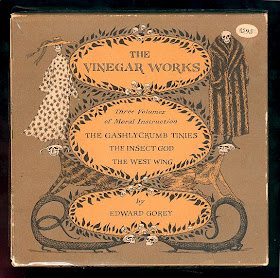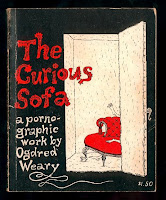 1963 brought forth what is un- doubtedly Edward Gorey's best known and most quoted book - The Gash- lycrumb Tinies. Published by Simon and Schuster, New York, TGT is one of three hardcover books that formed The Vinegar Works, Three Volumes of Moral Instruction. The other two books in the set are The Insect God and The West Wing. All three books are reprinted in Amphigorey.
1963 brought forth what is un- doubtedly Edward Gorey's best known and most quoted book - The Gash- lycrumb Tinies. Published by Simon and Schuster, New York, TGT is one of three hardcover books that formed The Vinegar Works, Three Volumes of Moral Instruction. The other two books in the set are The Insect God and The West Wing. All three books are reprinted in Amphigorey.Published together as a three volume set, The Vinegar Works is the first time that Edward Gorey released three new titles at one time packaged in a boxed set. In the upcoming Three Books from the Fantod Press I, II, III & IV, Gorey would continue to release multiple books which had to be purchased as sets. The Vinegar Works has the most elaborate slipcase design EG would ever design, with each of the five sides having new artwork specifically designed to showcase the books contained within.
 What can be said about The Gashlycrumb Tinies that hasn't been written before? From Amy who fell down the stairs to Zillah who drank too much gin, this classic Gorey alphabet book shows the perils that await unwary youth. This is probably Edward Gorey's most reprinted title. It appears in book form, on tee shirts, posters and is readily available today.
What can be said about The Gashlycrumb Tinies that hasn't been written before? From Amy who fell down the stairs to Zillah who drank too much gin, this classic Gorey alphabet book shows the perils that await unwary youth. This is probably Edward Gorey's most reprinted title. It appears in book form, on tee shirts, posters and is readily available today.Book two of the trilogy of moral instruction is The Insect God. This book was reprinted in 1986, and can still be found in hardcover. In this story, giant bugs kidnap and destroy poor little Millicent Frastly in a ghastly ritual. Should this book be required reading for all children about the dangers of accepting sweets and rides from strangers? Quite possibly...
The West Wing is a collection of drawings of rooms. This book has no text and none is needed. The settings go from unsettling to unusual and it is one of Gorey's more enigmatic books. It has been widely reported that Mr. Gorey dedicated this volume to Edmund Wilson after receiving repeated literary criticism from Mr. Wilson that many of EG's texts were found to be wanting when compared to his illustrations. Therefore, Gorey gave him a book to review with no words!
 The three volumes I have are all signed and inscribed by Mr. Gorey. This set was included in the exhibition Gorey Stories, Books and Drawings by Edward Gorey in the Leslie Memorial Room of the Minneapolis Institute of Arts, 1984/1985.
The three volumes I have are all signed and inscribed by Mr. Gorey. This set was included in the exhibition Gorey Stories, Books and Drawings by Edward Gorey in the Leslie Memorial Room of the Minneapolis Institute of Arts, 1984/1985.























